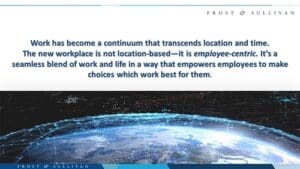Editor’s note: Commercial Integrator has teamed up with the IMCCA, the New York-based non-profit industry association for unified communication and workplace collaboration, to produce a quarterly supplement, titled Collaboration Today and Tomorrow, that focuses on all things collaboration from multiple perspectives.
After a handful of false starts, the return-to-office plans seem real this time. Countless workplace surveys and conflicting opinions later, each business is leading with its own take on hybrid work — with constant revisions and modifications to those plans. The reality is that we don’t know what hybrid work will look like five years from now or even a year from now. As a result, the dynamics of the workplace are constantly shifting. The role of the office will continue to evolve.
The question of what the future workplace will look like has been at the center of a heated debate for the last two years. The roaring success of remote work has changed employees’ as well as employers’ perceptions and attitudes forever. However, the implementation of hybrid work remains in flux with many business leaders and decision-makers undecided on what version will work best for their business. And they have good reasons to be slow to adopt — hybrid work is the biggest organizational and societal change that we have experienced in decades. Its real value remains unmeasured and hence unproven yet.
In Frost & Sullivan’s second survey since the start of the pandemic, 73% of the business leaders expect at least a quarter or more of their employees in the future to work from home part-time or full-time. This number stood at 93% last year during the peak pandemic months. About 26% plan to reduce office real estate as a result of the shift to hybrid work, as compared to 35% last year. These changes point to an interesting shift in mindset. It begs the question — as the fear of the pandemic and its variants subside, are businesses rethinking the role of hybrid work?
Varying Expectations
Business leaders and managers want employees to be back in the office. It makes complete sense — creativity, mentorship and teamwork often thrive best when people come together in person. Many employees recognize that and are indeed excited about the return to office. Some are finding comfort in being back at their desks in a familiar environment, away from the compromised workspaces and noisy environments at home. However, this newfound energy is also accompanied by a strong preference to have the flexibility to choose how often and when they want to be in the office so that they have the best of both worlds.
According to Microsoft’s 2022 Work Trend Index, 50% or more of the business leaders say their company is currently requiring or planning to require full-time in-person work in the year ahead, while 52% of employees say they are somewhat or extremely likely to consider going remote or hybrid in the year ahead. And therein lies the dilemma on how to practically implement hybrid work models that meet both the employee expectations of ultimate flexibility while assuring managers of maximum productivity and thriving teamwork.
The Path to Hybrid is Not Easy
For reasons mentioned above and more, hybrid work has become riddled with many uncertainties and complexities. Most businesses are offering a mix of remote and in-office policies in some shape or form today, but the outcomes are largely unknown. The implementation will remain a constantly shifting target. Planning, executing and measuring the efficacy of all changes will be an iterative process until businesses are satisfied with the outcomes.
Among the many challenging questions, for both today and the future, which business leaders must answer are the following:
- What is the right mix of in-office and remote work that will keep employees happy while ensuring that it enhances productivity, creativity and teamwork?
- How should they plan for office space and technology investments given the constant ebb and flow of in-office presence?
- How can they prepare for long-term investments in real estate and office space buildouts when the hybrid work policies are constantly changing?
- What is the fastest and most cost-efficient way to pilot and test new space and technology concepts and determine whether they match employee needs and preferences?
- How can they support business continuity that enables employees to switch to work from home at a moment’s notice if conditions change?
- How can they fully measure the efficacy of hybrid work and how often must they revisit their strategy?
There are no straightforward answers. One size does not fit all when it comes to hybrid work. It requires businesses to lead with agility, nimbleness and adaptation at a scale they haven’t experienced before. But most of all, it requires a sea change in how they evaluate and measure success. It means an increased focus on responding to employees’ wants and needs and measuring business success across metrics such as employee retention rate, ease of hiring talent, broad diversity and inclusion initiatives, and building a sustainable and equitable workplace.
View Archive: Visualizing the Hybrid Office – Solutions for Every Space
For too long, businesses have focused on financial performance and shareholder returns. In the new future of work, the businesses that will win are the ones with leaders willing to focus on employees as their primary stakeholders. They will also be the ones open to moving beyond an overriding focus on the physical location of work and provide various options to their workforce along with the necessary resources to be productive anywhere.
Stop Defining Hybrid Work by Location
Among the many ways to address the challenges ahead is to start by taking a fresh look at the term hybrid work. Today hybrid work is defined as a flexible work model where employees work partly in the physical office and partly at home or from another remote workspace. The definition of hybrid work itself is flawed because it’s location dependent.
Whether working in the office, at home, at a café or from an Airbnb, hybrid work essentially means omnipresent work. And therefore, the focus is always on the employee. A blanket policy that says “workers must be in the office three days a week” will not work and, in fact, will lead to loss of talent as employees move to companies that better fit their needs. Deciding where and how people work must be dependent on user personas, job roles and needs of the teams they interact with, and most importantly, a full empathetic understanding of individual choices and preferences.

The success of hybrid work hinges on creating the best employee experience—across functional initiatives that spans top management, HR, facilities and IT.
Reenergize and Reinvent the Office
If managers want employees to come back to the office, they must make the office experience better than being at home. Work has changed drastically over the last two years. Most offices haven’t. Forward-thinking businesses are now setting their sights on redesigning their offices to create vibrant, engaging and more technology-infused spaces.
The office of the future must be centered on a design that fits the new purpose and activities of the hybrid worker. It is a myth that people will only want to be back at the office because of their desire to see each other. Many employees want to be at the office because they want a “heads-down” space — a distraction-free environment and a professional place where they can get their best work done. The newer types of spaces, therefore, include a variety of options that allow for socialization, collaboration, learning, focus and relaxation. These include hot desks, open collaboration spaces, focus rooms, jump spaces, meeting pods, flex work areas, huddle rooms, think spaces, work cafes, open-air spaces and communal information areas.
As teams get increasingly dispersed, there is also the need for more meeting rooms. Meeting room buildouts must be thoughtful keeping in mind the new workstyles and a greater need for making the most of employees’ time at the office. There is a growing focus to turn meeting rooms into high-impact spaces that offer all the modern technologies required for employees to be at their productive best. This includes intelligent audio and videoconferencing, high-quality displays and digital whiteboarding for rich collaboration — all paired with AI and analytics for better insights into usage, performance and engagement.
Businesses are also investing in technologies that ensure maximum space and technology utilization such as wayfinding apps, automated space scheduling software, scheduling panels that display meeting room availability and room health metrics, in-room digital meeting controllers for fast one-click-to-join meetings, and room sensors that not only ensure optimal occupancy but also release the space if the meeting ends early or if the participants don’t show up.
Watch Webcast: Collaboration 2.0: Where Are We Now?
Equally important is a growing need to create inclusive video meetings for all — remote as well as in-room participants. There are several enablers here. For example, there is paying attention to the correct furniture and camera placement. Another consideration is investing in modern cloud-meeting platforms that use AI-powered technologies to individually re-frame meeting participants who are spread across the room.
These technologies then display them individually to remote attendees in the online meeting view, delivering an optimized collaboration experience for all participants. In addition, multi-camera support and camera switching are now allowing better views of all participants in a large room.
All workspaces in the future will be built with one common theme: They must invigorate employees and foster a spirit of creativity, collaboration and inclusivity. Most of all, it must be worth the time employees spend commuting to the office.
Hybrid Work is Worth the Time and Effort
The success of hybrid work hinges on creating the best employee experiences — a cross-functional initiative that spans top management, HR, facilities and IT. For managers, it means driving a cultural change that prepares them to lead with empathy.
For HR, it means training, evaluating, and empowering employees with a whole new lens centered on a human-centric approach.
For facilities, it means building optimized spaces that are agile and nimble to accommodate the peaks and troughs of employees who will access the office in a fluid manner.
Lastly, for IT, it means offering anytime, anywhere access to next-generation digital technologies while enhancing the ease of use, security and manageability.
The building blocks of hybrid work are taking shape today but will coalesce over the next several years to create an entirely new model of work, workplace, and employee experiences.
While there will be no uniformity in the implementation of hybrid work, one can clearly see the old and the new worlds blending. Every organization will need to find its unique place on the hybrid work spectrum based on its employee and business needs and accordingly optimize its workplace and office experience.
Most savvy businesses realize that, by merging the best of remote and in-office worlds, they have a unique opportunity to reinvent the way they do business and tap into cost savings, grow employee retention and raise productivity.










